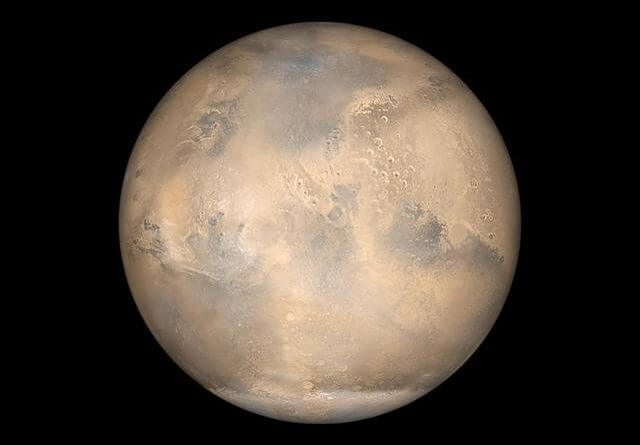Space Is The Place: The Night Sky Over Belper, October 2018
In October’s night sky: The Draconids Meteor Shower may be a good one this year. Moonlight will spoil the Orionids Meteor Shower. Mars is still bright – look for it in the south.
A Good Year for the Draconids?
The Draconids Meteor Shower usually has a low rate of activity (around 1 meteor per hour). The expectation is that this rate of activity will increase in 2018. This is because the parent Comet (21P/ Giacobini – Zinner) is nearer to the Sun this year. Predictions of the increased rate vary from around 15 meteors per hour to up to 50 ( Society of Popular Astronomy). If at the higher rate the shower could be comparable to those offered by the Perseids or the Geminids.
The Draconids are expected to peak just before midnight on the evening of Monday 8th of October and then into the early hours of the 9th. There is a new Moon on that night so the sky will be dark – which will aid visibility. Like any other meteor shower the Draconids will appear from all points of the sky. Choose a dark location, try and see as much of the sky as possible, and look upwards.
Note that the predicted rates are uncertain, it will be interesting to see what happens on the night.
…But Not So Good For The Orionids
The Orionids Meteors are produced by the particles left behind by Halley’s Comet. The meteors are bright, swift and leave persistent trails. Unfortunately, this year the peak of the Orionid Meteor shower conflicts with a waxing Moon. The predicted rate for the shower is around 20 meteors per hour but moonlight will drown out all but the brightest meteors.
Look for Orionids on the nights of the 21st to the 23rd from 10.00pm onwards. Look upwards, and to improve your chances of seeing a meteor look towards a dark region of the sky – keeping the Moon behind you.
The Planets:
Jupiter
Jupiter is low in the west. It is harder to spot now. Look for it just after sunset – a bright “star” in the evening twilight. The crescent Moon lies above Jupiter on the 11th.
Saturn
Saturn is low in the south-west. It is now only visible for a couple of hours after sunset. Its rings are open at the moment, an impressive sight even in a small telescope. A waxing crescent Moon is near to Saturn on the 14th / 15th.
Mars
Mars can be seen as a bright red “star” shining in the south as darkness falls. It is close to a waxing Moon on the nights of the 17th and 18th. A small telescope will resolve Mars into a small disc, close observation (or a larger telescope) may reveal some surface details. (Image of Mars – courtesy of NASA images).
International Space Station
The Spot the Station website is currently showing sightings up to 13th of October. ISS will track across the evening sky in time slots ranging from 6.57 pm to 9.01 pm over the next week or so. ISS fly pasts are relatively short, about a couple of minutes. To be sure of seeing the station it is best to check the Spot the Station site for the exact times, direction and duration of flypasts. It is also possible to sign up for text and email alerts using the link here: Space Station Alerts. The service only alerts you to good sighting opportunities, that is sightings that are high in the sky and of enough duration to have a chance of spotting the space station.
Derby And District Astronomical Society
The astronomical society’s next Introduction To Astronomy evening will be held on Friday 19th of October, from 7:30 pm onwards at The Friends Meeting House, St. Helens Street, Derby, DE1 3GY. DDAS member Mike Dumelow will be talking about telescopes and eyepieces. If you need help and advice with a telescope or binoculars then why not bring them along to the meeting and a member of the society will try to help.
The idea of the introductory meetings is to allow people more time to have their questions about astronomy answered and to discuss things at a greater length than at the ‘main’ meetings. There is a collection which helps pay for the rental of the Friends Meeting House which is £1 for members and £3 for non-members. If you would like more details please email DDAS Secretary Brian Dodson: secretary@derbyastronomy.org


GDPR, Your Data and Us: https://nailed.community/gdpr-your-data-and-us/